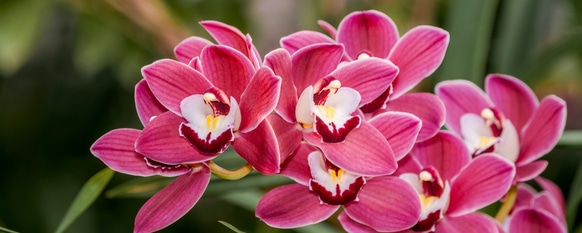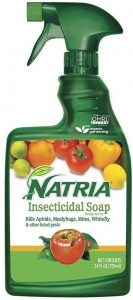These winter-blooming beauties, commonly called boat orchids, produce large 2 to 5-inch flowers on tall spikes. They are quite particular in their growing requirements, but if you can meet them, you’ll have a stunning floral display for months. A single mature plant can produce a dozen or more flower spikes arching gracefully over strappy yellow-green foliage.
The easily recognizable shape of 3 petals and 3 sepals, with a lower lip that attracts pollinators, makes these orchids popular as cut flowers and for use in corsages. They come in a wide array of colors: white, cream, orange, apricot, red, yellow, purple, burgundy, brown, and pink, often with contrasting spots.
Other than growing orchids, you’ll also want to keep other trees around your home healthy. Learn about trimming tips for boxwood to make sure your boxwood remain healthy.
From the Himalayas’ foothills and other parts of South Asia and Australia, cymbidium orchids thrive in an environment with warm days and cool nights. Those of us living in USDA hardiness zones 9 to 12 can grow them outdoors year-round. They love mountainous and coastal regions; in fact, Santa Barbara, California, has more commercial cymbidium growers than anywhere else in the United States.
In areas where winter temperatures get below freezing, cymbidiums can be grown outside in the summer and brought indoors in the autumn. This article is for those of you who live in Zones 8 and colder who are looking for a rewarding gardening challenge in getting a cymbidium to thrive and bloom year after year.

Bringing Your Cymbidium Home
Boat orchids are often sold in the winter when they are in bloom. It may be hard to choose a color from all the beautiful varieties there are! Handle your new plant carefully so you do not to break the flower spikes and bring it home wrapped to protect it from the cold.
Winter Care
Once inside, choose a spot in bright light. Daytime temperatures should be between 65°F and 75°F, and nighttime temperatures should be between 45°F and 55°F. Not many of us keep our home this cool overnight, so try to find the coolest spot you can while still avoiding drafts. Indoor humidity should be between 40% and 60%. If the air in your home is dry, you can place the flower pot on a bed of wet pebbles or run a humidifier near your plant.
Water frequently enough to keep the potting medium slightly moist during the winter. Water should drain freely through the pot, and the pot should not sit in a water-filled saucer. Fertilize monthly during the winter with a 20-20-20 fertilizer at half strength.
Boat orchid blooms can last for months! When the flowers have finished blooming, you can trim the spikes all the way back to the base of the plant.
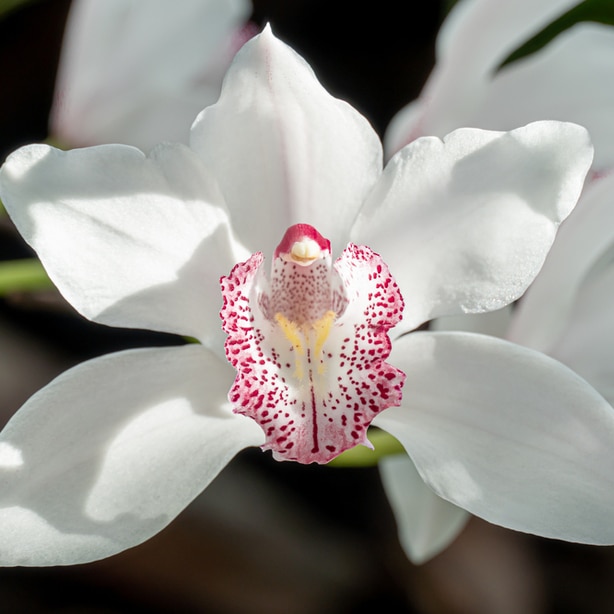
Growing Outdoors
Once the danger of frost has passed, you should bring your cymbidium outside. If kept indoors, the mechanisms these orchids need to bloom the next winter will not be triggered. They are semi-terrestrial, growing happily in the leaves and twigs of the forest floor, so don’t plant them in the ground. Keep them in their pots.
Light
Cymbidiums need bright, indirect light when they are growing outdoors. They will do well on the east side of the house or under a tree in dappled shade. If cymbidiums do not receive enough sunlight, their leaves turn dark green. Pale yellow leaves, on the other hand, indicate too much sunlight.
Gardeners in northern climes can grow cymbidiums in full sun. Again, watch for pale yellow leaves and sun scorch. During the hottest part of the year, these plants might need a bit of shade during the midday. Plants grown in full sun will require more frequent waterings.
When raising them indoors in the winter, grow these orchids in as much sunlight as possible.
Water
Watering frequency is dependent on weather conditions. Cymbidiums are thirsty plants, and during the growing season, you may need to water daily. Soak them deeply and thoroughly by running a sprinkler on them for a couple of hours. Water early in the morning. This gives the potting medium time to drain while still providing the moisture requirements that cymbidium needs for the day.
These orchids are sensitive to salts in the water. If your water is softened, you might want to use collected rainwater or distilled water instead of tap water. Leaves with brown tips indicate excess salts. These ends can be trimmed off and you can flush the salts out about once a month.
Reducing water as the temperatures drop also signals this orchid to start developing flower stalks.
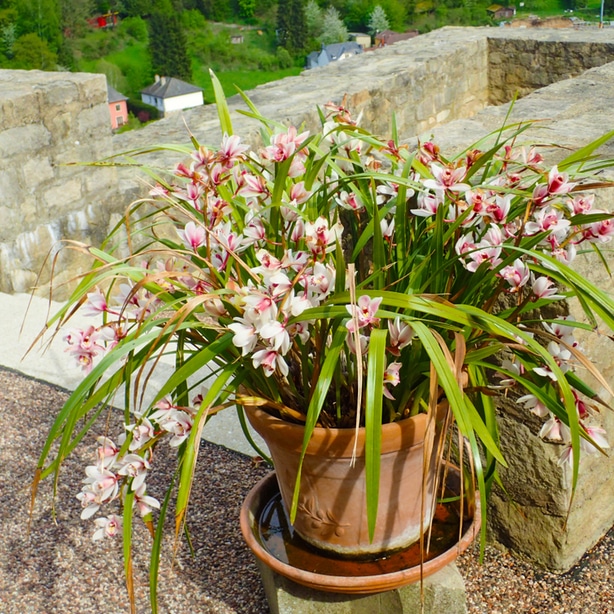
Make sure to also check out our care guide for dendrobiums here on the Green Pinky.
Temperature
The most critical element that encourages cymbidiums to flower is temperature. Flower spike formation initiates when night temperatures are 58°F or cooler. When nighttime temperatures get close to freezing, it is time to bring your plant inside. Boat orchids can take a light frost or two, but that is not recommended. If your nights are warm, try growing the miniature varieties – they can tolerate higher temperatures.

Fertilizer
Boat orchids are heavy feeders and require a year-long fertilizer regime to help them bloom:
- In early spring, use a slow-release fertilizer (like Osmocote). Sprinkle it over the top of the potting medium.
- Use a water-soluble 20-20-20 every two weeks from the beginning of December to July.
- In mid-July, switch to a lower nitrogen, higher phosphorus fertilizer to feed the developing blooms (“P,” the middle number). These fertilizers are often sold as ‘blossom boosters.”
A fertilizer formulated explicitly for orchids is a good option. As always, do not fertilize dry plants, as this can cause the foliage to burn.
First Frost: Bring Your Cymbidium Indoors Again
Cymbidiums can tolerate temperatures to 40°F, but bring your plant inside when frost is predicted. You can clean up your plant at this time, removing dead leaves and trimming brown ends. Locate an indoor spot that gets lots of natural light and keep an eye open for flower spikes. They grow up from the base of the plant and can sometimes be mistaken for new leaves.
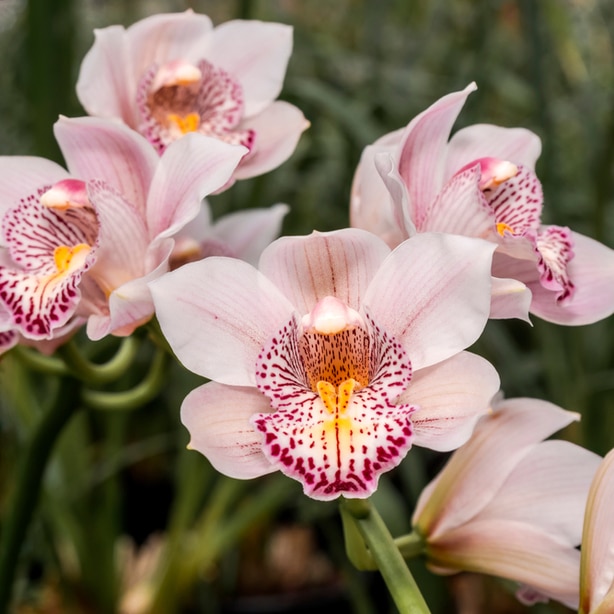
Dividing and Repotting
Cymbidiums don’t need to be repotted very often. They prefer to be crowded in their pots – they flower best then – and may only need to be divided every 2 to 3 years.
Repot in spring, when the plant has finished blooming.
When repotting, use a clay pot. The weight of a clay pot will stabilize your orchid and these pots also wick excess moisture, helping to keep the potting medium moist but not soggy.
You can use a commercial potting medium made especially for orchids, or you can make your own mix consisting of roughly:
- 40% peat moss
- 30% sphagnum moss, chopped up
- 20% medium grade pine bark
- 10% perlite
- Some growers like their potting mix to be 30% composted cow manure. You can adjust the other ingredients accordingly.
The quantities don’t have to be exact. Remember that the goal is to grow your orchid in a loose, coarse, airy medium that drains well but will stay moist.
Be sure the tools you use and the pot are clean and sanitized. Remove the plant from its existing pot and remove any dead leaves and roots. Use a sharp knife to cut the pseudobulbs (not true bulbs, but expanded stems) into three or four clumps.
Use a pot about 2 inches wider than the clump you are transplanting and deep enough to accommodate all the roots, with room for more to grow. Be careful not to break or damage the roots.

Common Problems
Cymbidiums are prone to spider mites, root rot, and bacterial diseases. Spider mites can be controlled with insecticidal soap or washed away with a strong blast of water. Root rot can be avoided by making sure your potting mix is well-draining. Prevent bacterial diseases by making sure all pots, media, and tools you use are clean.
Bud blast can occur when cymbidiums are moved while the flower stalks are developing. To avoid this, don’t move your plant once you bring it indoors in the autumn.
We’ll admit that caring for cymbidium and getting them to reflower can be challenging. But if you can provide the growing conditions these orchids require, they will reward you with beautiful blooms for many years. There are orchid societies, magazines, and even YouTubers to help you delve deeper should you find yourself hooked!

